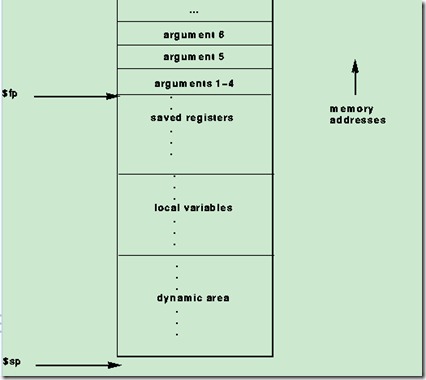栈帧示意图:stack pointer、frame pointer
更多参考:http://www.embeddedrelated.com/usenet/embedded/show/31646-1.php
一:
The calling convention described in this section is the one used by gcc, not the native MIPS compiler, which uses a more complex convention that is slightly faster.

Figure 6: Layout of a stack frame. The frame pointer points just below the last argument passed on the stack. The stack pointer points to the first word after the frame.
Figure 6 shows a diagram of a stack frame. A frame consists of the memory between the frame pointer ($fp), which points to the word immediately after the last argument passed on the stack, and the stack pointer ($sp), which points to the first free word on the stack. As typical of Unix systems, the stack grows down from higher memory addresses, so the frame pointer is above stack pointer.
The following steps are necessary to effect a call:
- Pass the arguments. By convention, the first four arguments are passed in registers $a0-$a3 (though simplier compilers may choose to ignore this convention and pass all arguments via the stack). The remaining arguments are pushed on the stack.
- Save the caller-saved registers. This includes registers $t0-$t9, if they contain live values at the call site.
- Execute a jal instruction.
Within the called routine, the following steps are necessary:
- Establish the stack frame by subtracting the frame size from the stack pointer.
- Save the callee-saved registers in the frame. Register $fp is always saved. Register $ra needs to be saved if the routine itself makes calls. Any of the registers $s0- $s7 that are used by the callee need to be saved.
- Establish the frame pointer by adding the stack frame size to the address in $sp.
Finally, to return from a call, a function places the returned value into $v0 and executes the following steps:
- Restore any callee-saved registers that were saved upon entry (including the frame pointer $fp).
- Pop the stack frame by adding the frame size to $sp.
- Return by jumping to the address in register $ra.
二:
Here's how I diagram the conventional PDP-11 stack layout.
| | higher addresses
+---------------+
| argN |
| ... |
| arg0 | <- FP+4
+---------------+
| link reg | <- FP+2 = SP after JSR
+===============+
| saved FP | <- FP after prologue
+---------------+
/ | locals | <- FP-2
framesize \ | ... |
+---------------+
| saved regs |
| ... | <- SP after prologue
+---------------+
| | lower addresses
Note that local function arguments are at positive offsets from FP,
local variables are at negative offsets. Also note that the frame
pointer itself is among the callee-saved registers.
See here for a survey of subroutine linkage conventions:
http://www.cs.clemson.edu/~mark/subroutines.html
http://www.cs.clemson.edu/~mark/subroutines/pdp11.html (PDP-11
specific)
and here http://cm.bell-labs.com/cm/cs/who/dmr/clcs.html (original
PDP-11 C)
栈帧示意图:stack pointer、frame pointer的更多相关文章
- Java-JVM 栈帧(Stack Frame)
一.概述 栈帧位置 JVM 执行 Java 程序时需要装载各种数据到内存中,不同的数据存放在不同的内存区中(逻辑上),这些数据内存区称作运行时数据区(Run-Time Data Areas). 其中 ...
- frame pointer及其用途
1 什么是frame pointer frame pointer指向本函数栈帧顶,通过它可以找到本函数在进程栈中的位置.有专门的寄存器保存该值. 2 frame pointer有什么用 主要是back ...
- C函数调用过程原理及函数栈帧分析(转)
在x86的计算机系统中,内存空间中的栈主要用于保存函数的参数,返回值,返回地址,本地变量等.一切的函数调用都要将不同的数据.地址压入或者弹出栈.因此,为了更好地理解函数的调用,我们需要先来看看栈是怎么 ...
- IDA Pro 权威指南学习笔记(十) - 栈帧
栈帧(stack frame)是在程序的运行时栈中分配的内存块,用于特定的函数调用 如果一个函数没有执行则不需要内存,当函数被调用时就需要用到内存 1.传给函数的参数的值需要存储到函数能够找到它们的位 ...
- 深入理解java虚拟机(十) Java 虚拟机运行时栈帧结构
运行时栈帧结构 栈帧(Stack Frame) 是用于虚拟机执行时方法调用和方法执行时的数据结构,它是虚拟栈数据区的组成元素.每一个方法从调用到方法返回都对应着一个栈帧入栈出栈的过程. 每一个栈帧在编 ...
- Java虚拟机之栈帧
写在前面的话:Java虚拟机是一门学问,是众多Java大神们的杰作,由于我个人水平有限,精力有限,不能保证所有的东西都是正确的,这里内容都是经过深思熟虑的,部分引用原著的内容,讲的已经很好了,不在累述 ...
- java 栈和栈帧
文章转载自:http://www.tuicool.com/articles/URZrMnb jvm为每个新创建的线程都分配一个堆栈.堆栈以帧为单位保存线程的状态.jvm对堆栈只进行两种操作:以帧为单位 ...
- 详细解析Java虚拟机的栈帧结构
欢迎关注微信公众号:万猫学社,每周一分享Java技术干货. 什么是栈帧? 正如大家所了解的,Java虚拟机的内存区域被划分为程序计数器.虚拟机栈.本地方法栈.堆和方法区.(什么?你还不知道,赶紧去看看 ...
- 【转载】深入理解Java虚拟机笔记---运行时栈帧结构
栈帧(Stack Frame)是用于支持虚拟机进行方法调用和方法执行的数据结构,它是虚拟机运行时数据区的虚拟机栈(Virtual Machine Stack)的栈元素.栈帧存储了方法的局部变量表,操作 ...
随机推荐
- 解决分批次调用 jsonp 接口的 callback 会报错问题
当我们分批次调用同一个jsonp接口时,会有一定机率同时调用,而jsonp的callback不支持同时调用, 会报错,所以当我们在分批次调用同一jsonp接口时,最好在callback后加个变量值,总 ...
- tp5.0
入口文件绑定 : define('BIND_MODULE','admin/index'); 配置 auto_bind_moudle = ture|false. 入口自动绑定模块 入口文件 defin ...
- 【研究】struts2-045漏洞
攻击者可以通过构造HTTP请求头中的Content-Type值可能造成远程代码执行. 工具: K8(链接:https://pan.baidu.com/s/1kVxgFNx 密码:ygxf) Tomca ...
- jdk8涉及到的接口、类及方法
bi是binary的简写,二元的,表示两个参数 unary,一元的,表示一个参数 1.函数式接口Supplier T get(),不接收参数,有返回值 IntSupplier,int getAsInt ...
- nginx 配置优化指令
worker_processes worker_processes指令是用来设计Nginx进程数,官方默认设为1,赋值太多了,将会对系统IO影响效率,降低Nginx服务器性能.但是为了让多核CPU能够 ...
- Linux下Tomcat如何传入'$'符号
在实际的工作中,有同事有需求要在Tomcat的启动脚本中添加启动参数,而且启动参数中带有特殊的字符'$',在实际的应用程序中,使用System.getProperty()进行获取设置的值,但是这个字符 ...
- cxf 框架 webservice
cxf 内置了一个web服务器 cxf简单入门实例 package test; import org.apache.cxf.jaxws.JaxWsServerFactoryBean; import c ...
- 面试题-Java设计模式举例
面试题-Java设计模式举例 1.适配器模式 涉及三个角色:Target目标接口.Adaptee源角色.Adapter适配器:Adapter将源接口适配到目标接口,继承源接口,实现目标接口. Java ...
- Linux之FTP篇
内容简介: vsftpd的安装 目录介绍 配置参数解释 锁定用户目录 其他用户不能登录 -------------------------------------------------------- ...
- linux下统计文本行数的各种方法(二)
上一篇讲的都是统计单个文件的方法,直接在命令行执行就可以.现在试试脚本的方式,统计多个文件的行数 一.统计目录下所有文件的文件数及所有行数 脚本暂时命名为count.sh,代码如下: #!/bin/b ...
